| Oct 18, 2024 |
|
(Nanowerk News) Rapid synthesis of high-entropy alloy nanoparticles (HEA NPs) offers a new opportunity to develop functional materials in various applications. Although some methods have successfully produced HEA NPs, these methods generally require rigorous conditions such as high pressure, high temperature, restricted atmosphere and limited substrates, which impede practical viability.
|
|
In a new paper published in Light: Science & Applications (“Laser solid-phase synthesis of graphene shell-encapsulated high-entropy alloy nanoparticles”), a team of scientists, led by Professor Zhu Liu from the Research Centre for Laser Extreme Manufacturing, Ningbo Institute of Materials Technology and Engineering, Chinese Academy of Sciences, have developed a laser solid-phase synthesis technique to produce graphene-shell encapsulated CrMnFeCoNi nanoparticles on 3D porous carbon-support.
|
 |
| Schematic diagram of the laser synthesis procedure for the CrMnFeCoNi HEA nanoparticles and IE-HEA/LIG. (Image: Light: Science & Applications)
|
|
Different from laser ablation in liquid, the laser solid-phase synthesis technique is a bottom-up approach, based on the laser irradiation of mixed metal precursors in solid-phase adsorbed on a 3D porous structure of laser-induced graphene to produce HEA nanoparticles.
|
|
1) the CrMnFeCoNi HEA nanoparticles are embraced by several graphene layers, forming graphene shell-encapsulated nanoparticles;
|
|
2) the synthesis can be achieved through mixed metal precursor adsorption, thermal decomposition, and reduction via electrons from laser-induced thermionic emission, and the synthesis only takes less than 1 ms;
|
|
3) this technique also presents high versatility, evidenced by the successful synthesis of several materials including CrMnFeCoNi oxide, sulfide and phosphide nanoparticles; and
|
|
4) the laser-synthesized graphene shell-encapsulated CrMnFeCoNi NPs on the carbon support exhibit excellent electrocatalytic activity towards oxygen evolution reaction with an overpotential of 293 mV at the current density of 10 mA/cm2 and exceptional stability over 428 hours in alkaline media, outperforming the commercial RuO2 catalyst and the relevant catalysts reported using other methods.
|
|
The catalyst productivity is around 30g/h at a laser power of 35 W, which could be scaled up.
|
|
“Our strategy provides simplicity, generality and tunability to synthesize phase-separation-free HEA nanoparticles which consist of immiscible elements,” the authors note. “The graphene shell encapsulated HEA nanoparticles loaded on the carbon support can be directly used as 3D binder-free integrated electrodes, embodying the scalability of this synthesis technique. This method is economically feasible and technically viable to synthesize composition-tunable nanoparticles”.
|
|
“In addition, this technique may be applied as a rapid tool for high-throughput screening and data-driven discovery of HEA materials, in the development of catalysis and other applications”, the team added.
|


